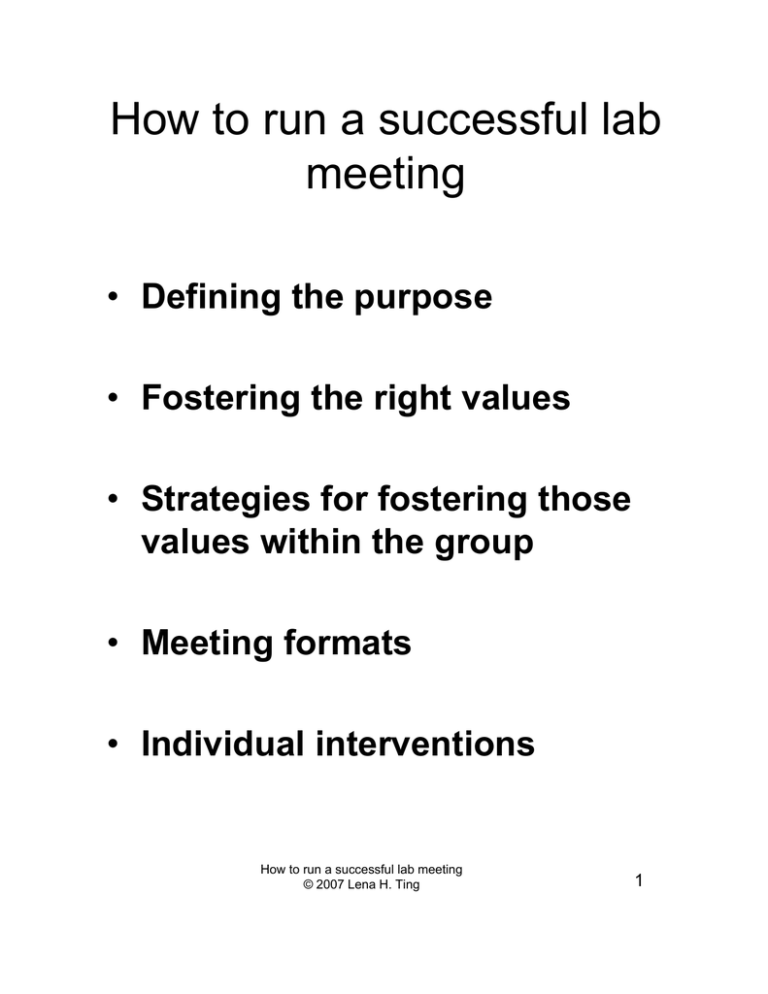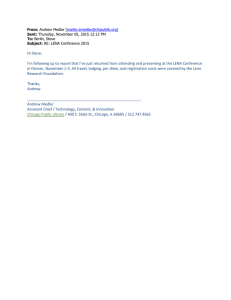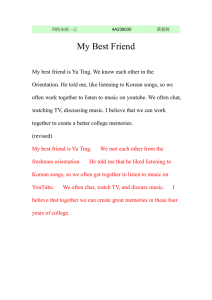How to run a successful lab meeting
advertisement

How to run a successful lab meeting • Defining the purpose • Fostering the right values • Strategies for fostering those values within the group • Meeting formats • Individual interventions How to run a successful lab meeting © 2007 Lena H. Ting 1 Your lab meeting reflects your values as a leader • This is your chance to establish and cultivate you lab culture. • What happens in lab meetings will influence how lab members interact outside of lab meeting. • Make a conscious decision about what your lab culture is and be aware of how your actions support or contradict that culture • Caveat: this presentation is based on my values--yours may differ How to run a successful lab meeting © 2007 Lena H. Ting 2 Purpose of a lab meeting (example from Ting lab) • To establish a lab culture that permeates all lab activities • To share ideas • To practice communication skills • To foster a sense of participation and integration among all members • To practice team problem-solving and decision-making • To foster critical thinking • To maximize the success of all projects by leveraging the diverse skills and experience of lab members • To celebrate individual and team achievements • To disseminate information How to run a successful lab meeting © 2007 Lena H. Ting 3 Lab meeting statement (from my “Welcome to the lab” document) • • Lab meeting are a chance for the lab to tackle each others problems together. Each week you are expected to bring a result or issue to the group. Usually it is helpful to bring a plot. What you talk about at the meeting does not have to be a comprehensive list of what you have accomplished during the week. Since time is brief it is useful to prepare your main point in advance. Your 5 minutes is best used to get input from others in the lab about how to tackle a problem, analyze data, interpret data, decide how to proceed. We have a lot of people with diverse backgrounds and different areas of expertise in the lab, so you never know who will be able to provide you with useful information. Full participation in lab meetings by all members, no matter how junior or senior is mandatory. Therefore, make sure when you speak in lab that you are speaking to the whole group, and that everyone present understands the big picture of what you are doing. Likewise, if you don’t understand what someone in the lab is saying, ASK! It is expected that everyone will have different strengths and weaknesses, but at the very least everyone should be able to describe the basic aims and approaches of all the projects in the lab. How to run a successful lab meeting © 2007 Lena H. Ting 4 But actions speak louder than words… • If you want to convey an authoritarian style: – Sit at the head of the table – Call on people rather than asking for volunteers – Nod with understanding and encouragement when jargon is used – Allow students to look at you when speaking to the group or to other members – Give your solution or opinion before allowing others to provide feedback or ask questions – Allow lab members to appear distracted or confused when others are speaking – P.S. First stating the obvious opposite of what you want to communicate is an effective teaching device How to run a successful lab meeting © 2007 Lena H. Ting 5 To convey a collaborative style: • Participate as an equal member – Put yourself on the lab presentation schedule – Provide updates--ask for feedback on a figure for a talk, an abstract, ideas, etc. – Sit wherever – Give responsibilities such as managing the presentation schedule or lab food to others – Don’t be afraid to say “I don’t understand that, can you explain it again?” How to run a successful lab meeting © 2007 Lena H. Ting 6 To convey a collaborative style: • Participate as a facilitator – Ensure that students don’t cut each other off or speak too critically – Allow members to sit silently and think after each update; students take longer to process information – Prompt students to get feedback about their communication (“e.g. do you think everyone knows what PCA is?”) – Encourage students with confused looks to answer questions (e.g. “Does everyone understand the goal of this project?”, or “Fred, do you know what PCA is?”) – Make high-level connections that may not be obvious to students (e.g. “This reminds me of a problem that Ann had on a different project--Ann?”) – If a student is having trouble expressing an idea, ask for volunteers to help them, instead of stepping in yourself How to run a successful lab meeting © 2007 Lena H. Ting 7 Sometimes you are the authority • Your input is valuable when: – You clear up confusion about a definition or concept – You provide a historical interpretation of findings or ideas – You manage students who are going off on tangents or talking at length without making a point. – You decide when a conversation should go offline – You prompt student to address the big picture – You provide your feedback after everyone else’s ideas are exhausted How to run a successful lab meeting © 2007 Lena H. Ting 8 Lab meeting formats • Different types of interactions allow students to practice skills in a variety of ways. • Possible lab meeting components: – – – – – – “Formal” presentations Weekly updates Journal article summaries Abstract/Poster jam sessions Announcements Factoid of the week How to run a successful lab meeting © 2007 Lena H. Ting 9 “Formal” presentations • A chance to present ideas and get feedback in more depth • I like short presentations (<15 min, <10 slides), with at least as much time for questions and discussion. • To dispel the idea that the work has to be “done” to be presented I allow presentations about “anything”, e.g: – – – – – – – – – An idea for a project A literature review A single paper Problematic data, confusing findings Analyses that didn’t work Analyses that worked A tutorial on a technique they mastered Something they learned in class A paper outline How to run a successful lab meeting © 2007 Lena H. Ting 10 Abstract/Poster jam sessions • Useful before abstract deadlines and conferences – Start 3 weeks in advance – Bring copies of a “fantasy” abstract or poster (e.g. write about your ideal results if you don’t have real ones yet, sketch out the figures and layout) – Have each member circle the motivation, hypothesis, general method, result, and implications in someone else’s abstract – Have each member suggest a single statement summarizing the motivation, hypothesis, general method, result, and implications of someone else’s abstract if these are not clear – Have members try to summarize the main point of their own or someone else’s abstract in 10 words or less. How to run a successful lab meeting © 2007 Lena H. Ting 11 Sometimes individual interventions can help • Privately, you may ask a student to: – Try to ask a question at every lab meeting • Usually they feel inadequate, and reason that if they “just understood X”, then they would “get it” • I try to explain: – That they aren’t responsible for knowing everything, but they are responsible for speaking up when they don’t understand – That usually when they don’t understand it is because of poor communication or poor assumptions made on the part of the speaker (“and not because you are stupid”) – That they should at least understand the big picture of everyone’s project; and everyone should be able to explain the big picture of their project – That they have a valuable contribution to make as a junior member because our experiences differ – That it’s more efficient to ask when you have a question rather than looking up or figuring out the answer later…which is a nice idea but usually doesn’t happen (why are they always surprised when I say this?). How to run a successful lab meeting © 2007 Lena H. Ting 12 Sometimes individual interventions can help • I often have second semester grad students give a 5-minute summary of a paper each week – Gets them motivated to read literature – Gives them a chance to say something substantial at meetings – Allows others to help them understand the literature – Helps them understand the culture of reading papers (they usually forget to report the title, authors, journal, year) – Allows group discussion of classic or new research – Gives me a chance to provide a historic perspective of our research How to run a successful lab meeting © 2007 Lena H. Ting 13 However you structure your lab meeting… • Be patient – It takes time for students to learn and to develop a lab culture • Have fun – We often laugh and share silly anecdotes – Don’t be afraid to laugh at yourself – We often play the “10-words-or-less game” when someone is having trouble explaining themselves • Notice progress and provide praise – When quiet students start to speak up – When students have obviously prepared what they will say in their update – When your students eventually ask all of your questions for you – When there is a productive lab meeting in your absence How to run a successful lab meeting © 2007 Lena H. Ting 14


